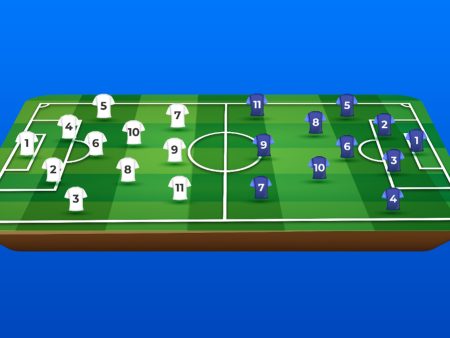In the ever-evolving world of football tactics, the low block remains a cornerstone of defensive strategy. From underdog teams seeking to level the playing field to elite clubs aiming to neutralise formidable opponents, the low block is a tactic that continues to shape outcomes in modern football.
Let’s delve into the intricacies of the low block, exploring its mechanics, benefits, challenges, and the teams that have mastered its implementation.
Understanding the Low Block in Football: What Is It?
The low block is a defensive tactic where a team positions its defensive line deep in its own half, often just outside the penalty area. This compact defensive shape aims to limit space for the attacking team, making it difficult for them to create scoring opportunities. The defending team reduces gaps that attackers could exploit by maintaining a close proximity between defenders and midfielders. This strategy often involves conceding possession, focusing instead on maintaining a solid defensive structure.
Why Do Teams Use a Low Block Tactic?
Teams employ a low block for various reasons:
- Neutralising Strong Opponents: Against teams with superior attacking prowess, a low block can stifle creativity and limit goal-scoring chances.
- Protecting a Lead: When leading, teams may adopt a low block to preserve their advantage by minimizing defensive vulnerabilities.
- Counter-Attacking Opportunities: By drawing opponents forward, teams can exploit the space left behind through swift counter-attacks.
This tactic requires discipline, communication, and a collective commitment to defense.
How Does the Low Block Work?
Implementing a low block involves several key components:
- Compact Defensive Line: Defenders stay close together, reducing spaces between them.
- Midfield Support: Midfielders drop back to support the defense, creating a dense central area that’s hard to penetrate.
- Limited Pressing: Instead of pressing high, the team allows the opposition to have the ball in non-threatening areas.
- Quick Transitions: Upon regaining possession, the team transitions rapidly to attack, aiming to catch the opposition off-guard.
This approach demands high levels of concentration and coordination among players.
Strengths of the Low Block
The low block offers several advantages:
- Defensive Solidity: By congesting the defensive third, it becomes challenging for opponents to find clear paths to goal.
- Energy Conservation: Less pressing means players can conserve energy, which is beneficial over the course of a match.
- Counter-Attacking Potential: With opponents pushed forward, there’s space to exploit behind their lines.
These strengths make the low block an effective strategy, especially for teams facing stronger adversaries.
Weaknesses of a Low Block
Despite its benefits, the low block has its drawbacks:
- Invites Pressure: Allowing the opposition to control possession can lead to sustained pressure.
- Limited Offensive Options: With most players committed to defense, attacking opportunities can be scarce.
- Susceptibility to Long Shots: Opponents may resort to long-range efforts, which can be dangerous if not properly closed down.
Teams must weigh these risks when deciding to employ a low block.
Famous Teams and Coaches Who Use the Low Block
Several renowned teams and managers have successfully utilized the low block:
- Atletico Madrid under Diego Simeone: Known for their disciplined 4-4-2 formation, they’ve frustrated many top teams with their defensive resilience.
- Inter Milan under Jose Mourinho: Their 2009-10 UEFA Champions League campaign showcased a masterclass in low block defense, particularly against Barcelona.
- Burnley under Sean Dyche: Utilized a compact 4-4-2 to maintain Premier League status against the odds.
These examples highlight the low block’s effectiveness at various levels of competition.
How to Break Down a Low Block
Overcoming a low block requires strategic planning:
- Width and Overlaps: Stretching the defense horizontally can create gaps to exploit.
- Quick Ball Movement: Rapid passing can disrupt the defensive shape.
- Long Shots: Taking shots from distance can test the goalkeeper and create rebound opportunities.
- Individual Brilliance: Skillful players can dribble past defenders or make incisive passes to unlock the defense.
Patience and creativity are essential when facing a well-organized low block.
The Low Block in Modern Football
In today’s game, the low block remains relevant:
- Tactical Flexibility: Teams switch between pressing and sitting deep based on match situations.
- Data-Driven Decisions: Analytics help coaches determine when to employ a low block effectively.
- Player Adaptability: Modern players are trained to execute various defensive strategies, including the low block.
Its continued use underscores its value in the tactical arsenal of football teams.
Summary: Key Takeaways on the Low Block
- Definition: A defensive tactic in football involving a deep, compact formation to limit opposition scoring chances.
- Purpose: Used to neutralize stronger opponents, protect leads, and create counter-attacking opportunities.
- Strengths: Defensive solidity, energy conservation, and potential for quick transitions.
- Weaknesses: Invites pressure, limits offensive options, and can be vulnerable to long shots.
- Notable Users: Atletico Madrid, Inter Milan, Burnley, and managers like Simeone, Mourinho, and Dyche.
- Counter Strategies: Utilizing width, quick ball movement, long-range shots, and individual skill.
Understanding the low block is crucial for appreciating the tactical nuances of modern football.














